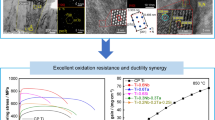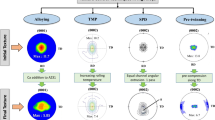Abstract
Lowering stacking fault energy (SFE) of face-centered cubic (fcc, e.g., Cu) metals by adding alloying elements (e.g., Al) is an effective way to create nanotwins (NTs). In this work, nanostructured Cu thin films with different Al additions (0, 1, 5, and 10 at.%) were prepared by magnetron sputtering deposition on silicon and polymer substrate, respectively, to investigate the effect of lowering SFE on microstructural features and mechanical properties. The Al addition can effectively reduce the SFE of Cu thin films, which in turn promotes the formation of NTs and facilitate the growth of (111) texture but suppresses (100) texture of Cu–Al thin films. Increasing the Al addition to ~10 %, the crossed NTs network emerges in the nanostructured Cu–Al thin films. The combined effect of texture and NTs on hardness and ductility was demonstrated, and an optimal hardness/ductility (6.2 GPa/6.3 %) combination was achieved in the Cu–5.0 at.% Al film. Our findings provide deep insight into tailoring the mechanical properties of Cu nanostructures by Al alloying.



Similar content being viewed by others
References
Christian JW, Mahajan S (1995) Deformation twinning. Prog Mater Sci 39:1
Lu L, Chen X, Huang X, Lu K (2009) Revealing the maximum strength in nanotwinned copper. Science 323:607
Beyerlein IJ, Zhang X, Misra A (2014) Growth twins and deformation twins in metals. Ann Rev Mater Res 44:329
Li X, Wei Y, Lu L, Lu K, Gao H (2010) Dislocation nucleation governed softening and maximum strength in nano-twinned metals. Nature 464:877
Qu S, An XH, Yang HJ et al (2009) Microstructural evolution and mechanical properties of Cu–Al alloys subjected to equal channel angular pressing. Acta Mater 57:1586
Zhang Y, Tao NR, Lu K (2011) Effects of stacking fault energy, strain rate and temperature on microstructure and strength of nanostructured Cu–Al alloys subjected to plastic deformation. Acta Mater 59:6048
Rohatgi A, Vecchio K, Gray G (2001) The influence of stacking fault energy on the mechanical behavior of Cu and Cu–Al alloys: deformation twinning, work hardening, and dynamic recovery. Metall Mater Trans A 32:135
Zhang X, Misra A, Wang H et al (2004) Enhanced hardening in Cu/330 stainless steel multilayers by nanoscale twinning. Acta Mater 52:995
Lu K, Lu L, Suresh S (2009) Strengthening materials by engineering coherent internal boundaries at the nanoscale. Science 324:349
Wu XL, Zhu YT (2008) Inverse grain-size effect on twinning in nanocrystalline Ni. Phys Rev Lett 101:025503
Freund LB, Suresh S (2004) Thin film materials: stress, defect formation and surface evolution. Cambridge University Press, Cambridge
Wang B, Idrissi H, Shi H et al (2012) Texture-dependent twin formation in nanocrystalline thin Pd films. Scripta Mater 66:866
Sonnweber-Ribic P, Gruber PA, Dehm G, Strunk HP, Arzt E (2012) Kinetics and driving forces of abnormal grain growth in thin Cu films. Acta Mater 60:2397
Thompson CV, Carel R (1996) Stress and grain growth in thin films. J Mech Phys Solids 44:657
Sonnweber-Ribic P, Gruber P, Dehm G, Arzt E (2006) Texture transition in Cu thin films: electron backscatter diffraction vs. X-ray diffraction. Acta Mater 54:3863
An XH, Wu SD, Zhang ZF, Figueiredo RB, Gao N, Langdon TG (2010) Evolution of microstructural homogeneity in copper processed by high-pressure torsion. Scripta Mater 63:560
An XH, Lin QY, Wu SD et al (2011) The influence of stacking fault energy on the mechanical properties of nanostructured Cu and Cu–Al alloys processed by high-pressure torsion. Scripta Mater 64:954
An XH, Lin QY, Wu SD et al (2011) Formation of fivefold deformation twins in an ultrafine-grained copper alloy processed by high-pressure torsion. Scripta Mater 64:249
Hamdi F, Asgari S (2010) Influence of stacking fault energy and short-range ordering on dynamic recovery and work hardening behavior of copper alloys. Scripta Mater 62:693
Velasco L, Polyakov MN, Hodge AM (2014) Influence of stacking fault energy on twin spacing of Cu and Cu–Al alloys. Scripta Mater 83:33
Goudeau P, Badawi KF, Naudon A, Gladyszewski G (1993) Determination of the residual stress tensor in Cu/W multilayers by X-ray diffraction. Appl Phys Lett 62:246
Zhang JY, Wu K, Zhang P et al (2012) An easy way to prepare layered nanoplatelets: fragment of nanostructured multilayers. J Appl Phys 111:113519
Zhang JY, Zhang P, Wang RH, Liu G, Zhang GJ, Sun J (2012) Grain-size-dependent zero-strain mechanism for twinning in copper. Phys Rev B 86:064110
Niu JJ, Zhang JY, Liu G et al (2012) Size-dependent deformation mechanisms and strain-rate sensitivity in nanostructured Cu/X (X = Cr, Zr) multilayer films. Acta Mater 60:3677
Tian Y, Xu B, Yu D et al (2013) Ultrahard nanotwinned cubic boron nitride. Nature 493:385
Zhang JY, Zhang P, Zhang X et al (2012) Mechanical properties of fcc/fcc Cu/Nb nanostructured multilayers. Mater Sci Eng A 545:118
Saha R, Nix WD (2002) Effects of the substrate on the determination of thin film mechanical properties by nanoindentation. Acta Mater 50:23
Niu RM, Liu G, Wang C, Zhang G, Ding XD, Sun J (2007) Thickness dependent critical strain in submicron Cu films adherent to polymer substrate. Appl Phys Lett 90:161907
Zhang JY, Zhang X, Wang RH et al (2011) Length-scale-dependent deformation and fracture behavior of Cu/X (X = Nb, Zr) multilayers: the constraining effects of the ductile phase on the brittle phase. Acta Mater 59:7368
Zhang J, Xu K, He J (1999) Effects of grain orientation on preferred abnormal grain growth in copper films on silicon substrates. J Mater Sci Lett 18:471
Kim SG, Park YB (2008) Grain boundary segregation, solute drag and abnormal grain growth. Acta Mater 56:3739
Zhang P, Zhang JY, Li J et al (2014) Microstructural evolution, mechanical properties and deformation mechanisms of nanocrystalline Cu thin films alloyed with Zr. Acta Mater 76:221
Chen XH, Lu L, Lu K (2011) Grain size dependence of tensile properties in ultrafine-grained Cu with nanoscale twins. Scripta Mater 64:311
Lu L, Shen Y, Chen X, Qian L, Lu K (2004) Ultrahigh strength and high electrical conductivity in copper. Science 304:422
Jin ZH, Gumbsch P, Ma E et al (2006) The interaction mechanism of screw dislocations with coherent twin boundaries in different face-centred cubic metals. Scripta Mater 54:1163
Hoagland RG, Kurtz RJ, Henager CH Jr (2004) Slip resistance of interfaces and the strength of metallic multilayer composites. Scripta Mater 50:775
Shabib I, Miller RE (2009) Deformation characteristics and stress–strain response of nanotwinned copper via molecular dynamics simulation. Acta Mater 57:4364
Acknowledgements
This work was supported by the National Natural Science Foundation of China (Grant Nos. 51321003, 51322104, 51201123), the 973 Program of China (Grant No. 2010CB631003), and the 111 Project of China (B06025). GL thanks the support from Fundamental Research Funds for the Central Universities and Tengfei Scholar project. JYZ thanks China Postdoctoral Science Foundation (2012M521765) and Shaanxi Province Postdoctoral Scientific Research Projects for part of financial support.
Author information
Authors and Affiliations
Corresponding authors
Rights and permissions
About this article
Cite this article
Zhang, P., Zhang, J.Y., Li, J. et al. Combined effect of texture and nanotwins on mechanical properties of the nanostructured Cu and Cu–Al films prepared by magnetron sputtering. J Mater Sci 50, 1901–1907 (2015). https://doi.org/10.1007/s10853-014-8753-7
Received:
Accepted:
Published:
Issue Date:
DOI: https://doi.org/10.1007/s10853-014-8753-7




